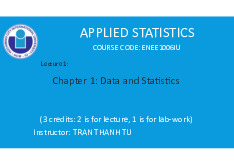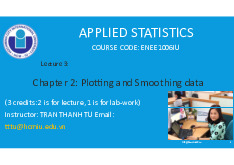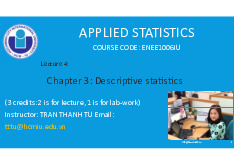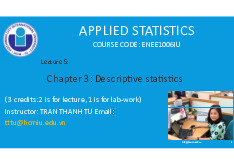



















Preview text:
APPLIED STATISTICS COURSE CODE: ENEE1006IU Lecture 2:
Chapter 1: Data and Statistics
(3 credits: 2 is for lecture, 1 is for lab-work) Instructor: TRAN THANH TU Email: tttu@hcmiu.edu.vn tttu@hcmiu.edu.vn 1 1.3. STATISTICAL INFERENCE •Sample, population
•Census, sample survey •Statistical inference tttu@hcmiu.edu.vn 2 1.3. STATISTICAL INFERENCE
•A population is the set of all elements of interest in a particular study.
•A sample is a subset of the population. tttu@hcmiu.edu.vn 3 1.3. STATISTICAL INFERENCE
• The process of conducting a survey to collect data for the entire population is called a census.
• The process of conducting a survey to collect data for a sample is called a sample survey. Sample survey Census
Only few units of the Each and every unit of the population is studied population is studied
It is most suitable if population It is most suitable if population is is homogeneous heterogeneous There is margin for error It is more accurate Take less time, man-power Take more time, man-power and tttu@hcmiu.edu.vn 4 and money money This is smaller in proportion
This is much bigger in proportion 1.3. STATISTICAL INFERENCE
Statistics uses data from a sample to make estimates and test hypotheses about the
characteristics of a population through a process referred to as statistical inference. tttu@hcmiu.edu.vn 5 tttu@hcmiu.edu.vn 6
1.4. ETHICAL GUIDELINES FOR STATISTICAL PRACTICE
•Professional Integrity and Accountability
•Integrity of data and methods
•Responsibilities to Science/Public/Funder/Client
•Responsibilities to Research Subjects
•Responsibilities to Research Team Colleagues
•Responsibilities to Other Statisticians or Statistics Practitioners
•Responsibilities Regarding Allegations of Misconduct
•Responsibilities of Employers, Including Organizations, Individuals, Attorneys, or
Other Clients Employing Statistical Practitioners tttu@hcmiu.edu.vn 7
1.4. ETHICAL GUIDELINES FOR STATISTICAL PRACTICE
• Unethical behavior can take a variety of forms including improper sampling, inappropriate
analysis of the data, development of misleading graphs, use of inappropriate summary statistics,
and/or a biased interpretation of the statistical results.
Ethical issues arise in statistics because of the important role statistics plays in the collection,
analysis, presentation, and interpretation of data.
1.4. ETHICAL GUIDELINES FOR STATISTICAL PRACTICE
• Developers of statistics: fair,
• Consumer of statistics: aware of the thorough, objective, and
neutral as you possibility of unethical statistical behavior collect data, conduct analyses, make
by others; view the information with some oral presentations, and present written
skepticism, always being aware of the reports containing information source as well as the purpose and developed.
objectivity of the statistics provided. tttu@hcmiu.edu.vn 9
1.4. ETHICAL GUIDELINES FOR STATISTICAL PRACTICE
•Professional Integrity and Accountability:
1. Identifies and mitigates any preferences on the part of the investigators or data providers that
might predetermine or influence the analyses/results.
2. Employs selection or sampling methods and analytic approaches appropriate and valid for the
specific question to be addressed, so that results extend beyond the sample to a population
relevant to the objectives with minimal error under reasonable assumptions.
3. Respects and acknowledges the contributions and intellectual property of others.
4. When establishing authorship order for posters, papers, and other scholarship, strives to make
clear the basis for this order, if determined on grounds other than intellectual contribution. tttu@hcmiu.edu.vn 10
1.4. ETHICAL GUIDELINES FOR STATISTICAL PRACTICE
•Professional Integrity and Accountability:
5. Discloses conflicts of interest, financial and otherwise, and manages or resolves them
according to established (institutional/regional/local) rules and laws.
6. Accepts full responsibility for his/her professional performance. Provides only expert
testimony, written work, and oral presentations that he/she would be willing to have peer reviewed.
7. Exhibits respect for others and, thus, neither engages in nor condones discrimination based
on personal characteristics; bullying; unwelcome physical, including sexual, contact; or other
forms of harassment or intimidation, and takes appropriate action when aware of such unethical practices by others. tttu@hcmiu.edu.vn 11
1.4. ETHICAL GUIDELINES FOR STATISTICAL PRACTICE
•Integrity of data and methods:
1. Acknowledges statistical and substantive assumptions made in the execution and interpretation
of any analysis. When reporting on the validity of data used, acknowledges data editing
procedures, including any imputation and missing data mechanisms.
2. Reports the limitations of statistical inference and possible sources of error.
3. In publications, reports, or testimony, identifies who is responsible for the statistical work.
4. Reports the sources and assessed adequacy of the data, accounts for all data considered in a
study, and explains the sample(s) actually used.
5. Clearly and fully reports the steps taken to preserve data integrity and valid results.
6. Where appropriate, addresses potential confounding variables not included in the study. tttu@hcmiu.edu.vn 12
1.4. ETHICAL GUIDELINES FOR STATISTICAL PRACTICE
• Integrity of data and methods:
7. In publications and reports, conveys the findings in ways that are both honest and meaningful
to the user/reader. This includes tables, models, and graphics.
8. In publications or testimony, identifies the ultimate financial sponsor of the study, the stated
purpose, and the intended use of the study results.
9. When reporting analyses of volunteer data or other data that may not be representative of a
defined population, includes appropriate disclaimers and, if used, appropriate weighting.
10. To aid peer review and replication, shares the data used in the analyses whenever
possible/allowable and exercises due caution to protect proprietary and confidential data.
11. Strives to promptly correct any errors discovered while producing the final report or after
publication. As appropriate, disseminates the correction publicly or to others relying on the results. tttu@hcmiu.edu.vn 13
1.4. ETHICAL GUIDELINES FOR STATISTICAL PRACTICE
•Responsibilities to Science/Public/Funder/Client:
1. To the extent possible, presents a client or employer with choices among valid alternative
statistical approaches that may vary in scope, cost, or precision.
2. Strives to explain any expected adverse consequences of failure to follow through on an
agreed-upon sampling or analytic plan.
3. Applies statistical sampling and analysis procedures scientifically, without predetermining the outcome.
4. Strives to make new statistical knowledge widely available to provide benefits to society at
large and beyond his/her own scope of applications.
5. Understands and conforms to confidentiality requirements of data collection, release, and
dissemination and any restrictions on its use established by the data provider (to the extent
legally required), protecting use and disclosure of data accordingly. Guards privileged information
of the employer, client, or funder. tttu@hcmiu.edu.vn 14
1.4. ETHICAL GUIDELINES FOR STATISTICAL PRACTICE
•Responsibilities to Research Subjects:
1. Keeps informed about and adheres to applicable rules, approvals, and guidelines for the
protection and welfare of human and animal subjects.
2. Strives to avoid the use of excessive or inadequate numbers of research subjects—and
excessive risk to research subjects—by making informed recommendations for study size.
3. Protects the privacy and confidentiality of research subjects and data concerning them,
whether obtained from the subjects directly, other persons, or existing records.
4. Knows the legal limitations on privacy and confidentiality assurances and does not over-
promise or assume legal privacy and confidentiality protections where they may not apply. tttu@hcmiu.edu.vn 15
1.4. ETHICAL GUIDELINES FOR STATISTICAL PRACTICE
•Responsibilities to Research Subjects:
5. Considers whether appropriate research-subject approvals were obtained before participating
in a study involving human beings or organizations before analyzing data from such a study and
while reviewing manuscripts for publication or internal use.
6. In contemplating whether to participate in an analysis of data from a particular source,
refuses to do so if participating in the analysis could reasonably be interpreted by individuals who
provided information as sanctioning a violation of their rights.
7. Recognizes any statistical descriptions of groups may carry risks of stereotypes and stigmatization. tttu@hcmiu.edu.vn 16
1.4. ETHICAL GUIDELINES FOR STATISTICAL PRACTICE
•Responsibilities to Research Team Colleagues:
1. Recognizes other professions have standards and obligations, research practices and standards
can differ across disciplines, and statisticians do not have obligations to standards of other
professions that conflict with these guidelines.
2. Ensures all discussion and reporting of statistical design and analysis is consistent with these guidelines.
3. Avoids compromising scientific validity for expediency.
4. Strives to promote transparency in design, execution, and reporting or presenting of all analyses. tttu@hcmiu.edu.vn 17
1.4. ETHICAL GUIDELINES FOR STATISTICAL PRACTICE
•Responsibilities to Other Statisticians or Statistics Practitioners:
1. Promotes sharing of data and methods as much as possible and as appropriate without
compromising propriety. Makes documentation suitable for replicate analyses, metadata studies,
and other research by qualified investigators.
2. Helps strengthen the work of others through appropriate peer review; in peer review,
respects differences of opinion and assesses methods, not individuals. Strives to complete review
assignments thoroughly, thoughtfully, and promptly.
3. Instills in students and non-statisticians an appreciation for the practical value of the concepts
and methods they are learning or using.
4. Uses professional qualifications and contributions as the basis for decisions regarding
statistical practitioners’ hiring, firing, promotion, work assignments, publications and
presentations, candidacy for offices and awards, funding or approval of research, and other professional matters. tttu@hcmiu.edu.vn 18
1.4. ETHICAL GUIDELINES FOR STATISTICAL PRACTICE
•Responsibilities Regarding Allegations of Misconduct:
1. Avoids condoning or appearing to condone statistical, scientific, or professional misconduct.
2. Recognizes that differences of opinion and honest error do not constitute misconduct; they
warrant discussion, but not accusation.
3. Knows the definitions of, and procedures relating to, misconduct. If involved in a misconduct
investigation, follows prescribed procedures. tttu@hcmiu.edu.vn 19
1.4. ETHICAL GUIDELINES FOR STATISTICAL PRACTICE
•Responsibilities Regarding Allegations of Misconduct:
4. Maintains confidentiality during an investigation, but discloses the investigation results
honestly to appropriate parties and stakeholders once they are available.
5. Following an investigation of misconduct, supports the appropriate efforts of all involved—
including those reporting the possible scientific error or misconduct—to resume their careers in
as normal a manner as possible.
6. Avoids, and acts to discourage, retaliation against or damage to the employability of those
who responsibly call attention to possible scientific error or to scientific or other professional misconduct. tttu@hcmiu.edu.vn 20
1.4. ETHICAL GUIDELINES FOR STATISTICAL PRACTICE
•Responsibilities of Employers, Including Organizations, Individuals, Attorneys, or
Other Clients Employing Statistical Practitioners:
1. Recognize that the ethical guidelines exist and were instituted for the protection and support
of the statistician and the consumer alike.



